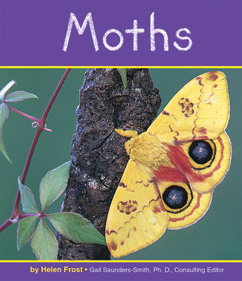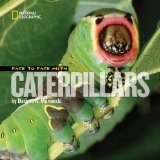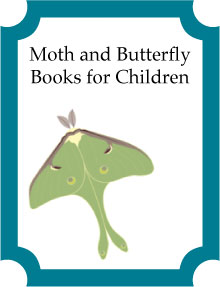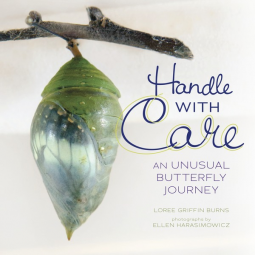Originally compiled in honor of National Moth Week, this list of children’s books about moths and butterflies has been growing steadily. The books are organized by genre and by reading level.
Why celebrate moths as well as butterflies? Because, as the website mentions, moths are numerous, diverse and successful, yet often ignored.
Board Books
The Butterfly Garden by Laura Weston
For the youngest reader, this lift-the-flap book has colorful life stages of the monarch butterfly hidden among black-and-white images of milkweed plants (contrast catches the eye of the youngest set). Lift the flap and discover the insect. It is very simple with only a few words.
Age Range: 2 – 5 years
Board book: 12 pages
Publisher: Big Picture Press; Reissue edition (April 11, 2017)
ISBN-10: 0763693170
ISBN-13: 978-0763693176
Beginning Readers:
National Geographic Readers: Caterpillar to Butterfly by Laura Marsh
Published in April 10, 2012, this book for 4 to 6-year-olds explains how a caterpillar transforms into a butterfly. It also includes some information about poisonous caterpillars, which is something children should be aware of. As to be expected of a book published by National Geographic, it is illustrated with large, high quality color photographs. There are a few activities in the back to reinforce learning.
Moths (Bugs Bugs Bugs)
by Fran Howard
Big color photographs are accompanied by simple, controlled-vocabulary text.
Reading Level: K-1
ISBN: 9780736836449 / 0-7368-3644-6
Publisher: Capstone Press – Pebble Plus (2005)

Moths (Insects) by Helen Frost
An introduction to some of the features of moths, including their colors, what their wings look like, and how they scare predators.
Reading Level: K-1
ISBN: 9780736808521 / 0-7368-0852-3
Publisher: Capstone Press- Pebble (2001)
Picture Books:
The perfect picture book to accompany National Moth Week is You’re Invited to a Moth Ball: A Nighttime Insect Celebration by Loree Burns and photographs by Ellen Harasimowicz.
Come meet some of the more than 150,000 species of moths by having a party. However, the party needs to be after dark, so you will have to stay up later than usual. Learn how to make a moth bait that will attract more buggy guests (recipe included). Or you can attract more moths by hanging a sheet over a line with a light shining through (instructions included). Then wait for the guests to arrive!
Reading age : 5 – 8 years
Publisher : Charlesbridge; Illustrated edition (April 7, 2020)
ISBN-10 : 1580896863
ISBN-13 : 978-1580896863
Jerry Pallotta’s Not a Butterfly Alphabet Book: It’s About Time Moths Had Their Own Book!, illustrated by Shennen Bersani.
Don’t let the name “alphabet book” dissuade you. Although they are wryly humorous (as you can tell from the title) and full of quirky facts, these are serious nonfiction books that use the alphabet as a way to organize information. This one highlights 26 different species of moths, from the giant Atlas moth to the gorgeous zigzag moth (you’ll see immediately how it got it’s name). Along the way readers learn about aspects of moth biology, such as facts about their mouthparts, wing scales, and life cycles.
Shennen Bersani’s amazing illustrations explode the myth that moths are drab or boring. You are likely to say, “Wow!” with every page turn. They are gorgeous. Seriously!
Not a Butterfly Alphabet Book will thrill budding entomologists and artists alike. Pick up a copy and find out why moths deserve their day in the sun.
Age Range: 3 – 7 years
Publisher: Charlesbridge (November 5, 2019)
ISBN-10: 1580896898
ISBN-13: 978-1580896894
Why include Not a Bean by Claudia Guadalupe Martínez and illustrated by Laura Gonzalez in a list of books about moths and butterflies?
It might be clearer when you find out the bean in question is a Mexican jumping bean. Still not clear? The Mexican jumping bean moves around because there is a tiny moth larva (caterpillar) inside.
Claudia Guadalupe Martínez starts the story with the plant that produces the bean and explains how the larva gets inside. Next she shows how the caterpillar within the bean behaves under natural conditions. When children find the bean, they use it for a simple racing game. After the bean stops jumping (because the caterpillar has pupated), the children abandon it. Later a moth emerges and the life cycle continues. Throughout she includes Spanish vocabulary words.
Because Not a Bean is multifaceted, it could be used either for a lesson on Spanish language and Mexican culture, or for a science unit on insects (or both!) Plus, who isn’t intrigued by a bean that jumps? Investigate a copy today!
Age Range: 3 – 7 years
Publisher: Charlesbridge (November 5, 2019)
ISBN-10: 1580898157
ISBN-13: 978-1580898157
Night Life of the Yucca: The Story of a Flower and a Moth
by Katherine B. Hauth and illustrated by Kay Sather
An older book which may be hard to find, but the story of the relationship between the yucca and the yucca moth is fascinating. See Gardening for Moths for an introduction to yucca moths.
Luna Moths: Masters of Change (Insect World)
by Sandra Markle
Reading level: Ages 7 and up
Paperback: 48 pages
Publisher: Lerner Classroom (September 1, 2007)
A Luna Moth’s Life (Nature Upclose) by John Himmelman
Reading level: Ages 5 and up
Paperback: 32 pages
Publisher: Children’s Press(CT) (September 1, 1998)
Crinkleroot’s Guide to Knowing Butterflies and Moths
by Jim Arnosky
Ages: 5-8
Hardcover: 32 pages
Publisher: Simon & Schuster Children’s Publishing; 1st edition (May 1, 1996)
A Butterfly Is Patient by Dianna Hutts Aston and illustrated by Sylvia Long
The team of Aston and Long have written and illustrated other award-winning books, such as An Egg is Quiet and A Seed is Sleepy. This new addition is even better, if that is possible. How do you top perfection? They found a way.
Start with the front endpapers, a collection of vibrant caterpillars with names like “Moonlight Jewel” and “Hieroglyphic Flat.” Skip to the back endpapers and you will find equally vibrant illustrations of the butterflies that come from those caterpillars. You can spend hours studying the endpapers alone.
Although it is beautiful, it is not lightweight. Aston has obviously done her research. She packs some hard science into the text, using words such as pollination, camouflage, predator, and migration.
At one point, the author writes, “A butterfly is spectacular!” The reader will immediately want to echo, “This book is spectacular, too!”
My full review at Wrapped in Foil blog
Nic Bishop: Butterflies and Moths by Nic Bishop
Nic Bishop is an award-winning photographer and his books are a visual treat. The information is accurate and well written.
Reading level: Ages 4 and up
Hardcover: 48 pages
Publisher: Scholastic Nonfiction (March 1, 2009)
What’s the Difference Between a Butterfly and a Moth? (What’s the Difference? (Capstone))by Robin Michal Koontz and Bandelin-Dacey
This is a beautifully-illustrated picture book describes the differences between butterflies and moths clearly. (Google books has a preview). It also would be useful for units on life cycles.
Reading level: Ages 7 and up (really grades K-3)
Library Binding: 24 pages
Publisher: Picture Window Books (August 1, 2009)
Wings of Light: The Migration of the Yellow Butterfly
by Stephen R. Swinburne and illustrated by Bruce Hiscock
We all know about the migration of the monarch butterfly, but there are other butterflies and moths that disperse or migrate over long distances. This particular book follows the migration of cloudless sulfur butterfly from the rainforests of Central America into the U.S. Long distance flight by such fragile creatures is amazing.
Age Range: 7 – 9 years
Grade Level: 1 – 4
Publisher: Boyds Mills Press (March 3, 2006)
ISBN-10: 1590780825
ISBN-13: 978-1590780824
From Caterpillar to Butterfly (Let’s-Read-and-Find-Out Science, Stage 1) by Deborah Heiligman and illustrated by Bari Weissman
This book is an account of a classroom caterpillar that undergoes metamorphosis into a beautiful painted lady butterfly. The Let’s Read and Find Out Science books are uniformly high quality and this title was named as a NSTA/CBC Outstanding Science Trade Book for Children.
Age Range: 4 – 8 years
Publisher: HarperCollins; Revised edition (August 4, 2015)
ISBN-10: 0062381830
ISBN-13: 978-0062381835
Are You a Butterfly? (Backyard Books)
by Judy Allen and Tudor Humphries
Part of Judy Allen and Tudor Humphries’ wonderful nonfiction series, asking the question “Are you…?” Are You a Butterfly? Are You a Grasshopper? Are You an Ant? All are beautifully done and well-researched books. The child is brought into the story in a creative way.
Reading level: Ages 5 and up
Paperback: 28 pages
Publisher: Kingfisher (May 16, 2003)
My, Oh My–A Butterfly!: All About Butterflies (Cat in the Hat’s Learning Library)
by Tish Rabe and illustrated by Aristides Ruiz and Joe Mathieu
Done in rhyme, these Cat in the Hat science books are very informative and fun to read.
Reading level: Ages 5 and up
Hardcover: 48 pages
Publisher: Random House Books for Young Readers (March 27, 2007)
Waiting for Wings by Lois Ehlert
This picture book for the youngest set is bright, bold and beautifully done. It traces the life cycle of a butterfly very simply, and then has a bit more in depth information about butterflies and flowers at the end. There’s even a page of information about butterfly gardening.
Butterfly or Moth?: How Do You Know? (Which Animal Is Which?) by Melissa Stewart (2011) uses color photographs to explore whether an insect is a butterfly or moth. For example, by asking, “Knobs or no knobs?” Stewart points out that butterflies often have knobs on the tips of their antennae, whereas moths often have feathery antennae.
Age Range: 5 and up
Publisher: Enslow Elementary (July 1, 2011)
ISBN-10: 1598452355
ISBN-13: 978-1598452358
It’s a Butterfly’s Life by Irene Kelly.
This nonfiction book has many lovely illustrations. If you are looking for a book for beginning reader, be aware that the font looks like hand lettering and the sentences wave up and down across the page, almost like the pattern of a butterfly flying. This looks lovely, but may be hard for a struggling reader to read. It has many interesting facts, and covers the butterfly life cycle in detail.
Hardcover: 32 pages
Publisher: Holiday House (April 15, 2007)
Where Butterflies Grow (Picture Puffins) by Joanne Ryder and illustrated by Lynne Cherry
This older book follows the life cycle of a black swallowtail butterfly step by step. Includes suggestions for growing a butterfly garden.
Age Range: 5 – 8 years
Grade Level: Kindergarten – 3
Publisher: Puffin; Reprint edition (June 1, 1996)
ISBN-10: 0140558586
ISBN-13: 978-0140558586
Newer picture books:
Butterflies in Room 6: See How They Grow by Caroline Arnold
Follow along with the children in Mrs. Best’s kindergarten class as they hatch painted lady caterpillars from eggs, feed them a special diet, and wait patiently for the butterflies to emerge from their chrysalids.
Caroline Arnold is both the author and photographer for the book and she has captured some fun and incredible images of both the insects and the children.
Age Range: 3 – 7 years
Publisher: Charlesbridge (March 12, 2019)
ISBN-10: 1580898947
ISBN-13: 978-1580898942
Life Story of a Butterfly (Animal Life Stories) by Charlotte Guillain explores the life stages of the monarch butterfly with bright, colorful close-up photographs. The reader will learn what the parts of a butterfly are called, how the young are different from the adults, how long they live, and where they go in the winter.
Age Range: 6 – 8 years
Publisher: Heinemann (July 1, 2014)
ISBN-10: 1484604873
ISBN-13: 978-1484604878
When Butterflies Cross the Sky: The Monarch Butterfly Migration (Extraordinary Migrations) by Sharon Katz Cooper and beautifully illustrated by Joshua S Brunet looks and reads like a fiction picture book. Don’t be fooled though, because it is filled with concepts and facts, especially relating to the migration of a female monarch south and back again.
Age Range: 5 – 9 years
Grade Level: 2 – 3
Publisher: Picture Window Books (February 1, 2015)
ISBN-10: 1479561045
ISBN-13: 978-1479561049
Handle With Care: An Unusual Butterfly Journey (Junior Library Guild Selection) by Loree Griffin Burns and with photographs by Ellen Harasimowicz is a lovely book for youngsters that will surely inspire a trip to a butterfly exhibit. It explains that the tropical butterflies seen in local butterfly exhibits come from butterfly farms, and then visit such a farm in Costa Rica. You will want to use it to accompany units on life cycles, farming, and insects. Read it and watch children’s imaginations take flight!
Full review and suggested activities at Growing with Science
Age Range: 6 – 10
Series: Junior Library Guild Selection (Millbrook Press)
Publisher: Millbrook Pr Trade (January 1, 2014)
ISBN-10: 0761393420
ISBN-13: 978-0761393429
How Does a Caterpillar Become a Butterfly?: And Other Questions about Butterflies (Good Question!) by Melissa Stewart and illustrated by Annie Patterson
Formulated in a question and answer format, the reader can quickly find information to write a report or satisfy curiosity. For example, do you know why the larval stage of a butterfly or moth is called a caterpillar? As Stewart points out, the word caterpillar comes from French words meaning “hairy cat.” Isn’t that so much more poetic than some other scientific terms?
Also, Stewart includes detailed information about how a butterfly is different than a moth on page 24, with a gorgeous photograph of a luna moth to accompany it.
Age Range: 7 and up
Publisher: Sterling Children’s Books (January 7, 2014)
ISBN-10: 1454906669
ISBN-13: 978-1454906667
Middle Grade
The Monarchs Are Missing: A Butterfly Mystery by Rebecca E. Hirsch.
Illustrated with large color photographs and clever illustrations, this book delves into all the reasons that monarch butterfly populations have been on the decline. Hirsch goes beyond the loss of habitat in the monarchs’ overwintering sites in Mexico.
Age Range: 8 – 12 years
Publisher: Millbrook Pr (January 1, 2018)
ISBN-10: 1512452505
ISBN-13: 978-1512452501


Face to Face with Caterpillars (Face to Face with Animals)(2009) and Face to Face with Butterflies (Face to Face with Animals)
(2010) by Darlyne Murawski
Darlyne Murawski is an award-winning photographer, as well as writer and biologist. Her expertise is evident in the bright full-color photographs in both these books from National Geographic’s Children’s Books. The caterpillar book starts with a close-up photograph of an Australian caterpillar eating an ant larva. Then we see a photograph of the author laying down under a sheet of plexiglass taking the shot. The book covers where to find caterpillars, their life-cycles, defenses, and a brief discussion of the differences between butterflies and moths.
DK Eyewitness Books: Butterfly and Mothby Paul Whalley
Filled with awesome illustrations and just enough information, it is all you’ve come to expect from DK Books.
Reading level: Ages 8 and up
Hardcover: 72 pages
Publisher: DK Publishing (2012)
Hands-On Activity Books (For Mixed Ages):
Butterfly Papercrafts: 21 Indoor Projects for Outdoor Learning by Sal Levinson and illustrated by Danielle Levinson.
This book introduces children to both art and science in an integrated way. Topics covered include the differences between butterflies and moths, butterfly life cycles, butterfly gardening, puddling behavior, migration, camouflage and more. To explore these topics, children make finger puppets, flip books, paper airplanes, and even a butterfly-shaped kite.
The layout consists of a series of two-page spreads with instructions and information about a given butterfly-related topic on the left page and the reproducible template for the craft to make on the right hand page. Also included are black and white photographs of completed projects or activity suggestions. What a wonderful way to learn about butterflies and moths!
Butterfly Papercrafts would be a great resource to have on hand for STEAM festivals, units on insects, to accompany a trip to a butterfly house, or for a rainy day craft project at home. A must have for children who love butterflies.
Paperback: 48 pages
Publisher: CreateSpace Independent Publishing Platform (March 7, 2015)
ISBN-10: 1508695377
ISBN-13: 978-1508695370
Caterpillarology (Backyard Buddies)
by Michael Elsohn Ross and illustrated by Darren Erickson and Brian Grogan is for children who are interested in science and doing science experiments with caterpillars. This book (and the others in the “-ology” series) are chock full of great information and fun activities. Although they are older, these books are truly unique and worth picking up.
Age Range: 7 and up
Grade Level: 2 and up
Library Binding: 48 pages
Publisher: Carolrhoda Books (November 1997)
ISBN-10: 1575050552
ISBN-13: 978-1575050553
The Family Butterfly Bookby Rick Mikula
Very popular book with projects and activities to do.
Reading level: Gr 5 up
Paperback: 176 pages
Publisher: Storey Publishing, LLC (October 11, 2000)
ISBN-10: 158017292X
ISBN-13: 978-1580172929
Field Guide/ Family suggestions:
The Life Cycles of Butterflies: From Egg to Maturity, a Visual Guide to 23 Common Garden Butterflies by Judy Burris and Wayne Richards
Too many times books concentrate on adult insects and forget about all the other stages an insect goes through. This book remedies that by giving the the full life cycles of 23 different butterflies. Illustrated with photographs of each stage, this book is truly unique.
Paperback: 160 pages
Publisher: Storey Publishing, LLC (April 1, 2006)
ISBN-10: 1580176178
ISBN-13: 978-1580176170
Caterpillars of Eastern North America: A Guide to Identification and Natural History (Princeton Field Guides) by David L. Wagner
Series: Princeton Field Guides
Paperback: 512 pages
Publisher: Princeton University Press; 1St Edition edition (August 14, 2005)
Language: English
ISBN-10: 0691121443
ISBN-13: 978-0691121444
Caterpillars in the Field and Garden: A Field Guide to the Butterfly Caterpillars of North America (Butterflies [Or Other] Through Binoculars) by Thomas J. Allen, James P. Brock, and Jeffrey Glassberg
Series: Butterflies [Or Other] Through Binoculars
Paperback: 240 pages
Publisher: Oxford University Press; First Edition edition (June 2, 2005)
Language: English
ISBN-10: 0195149874
ISBN-13: 978-0195149876
Peterson First Guide to Caterpillars of North America by Amy Bartlett Wright and edited by Roger Tory Peterson
Age Range: 11 and up
Grade Level: 6 and up
Series: Peterson First Guide
Paperback: 128 pages
Publisher: Houghton Mifflin Harcourt; 2nd edition (May 15, 1998)
ISBN-10: 0395911842
ISBN-13: 978-0395911846
Related:
Butterflies in Your Backyard downloadable .pdf from NC State University (link is in the bottom of text)
Related Fiction for Children:
Hurry and the Monarch by Antoine O Flatharta and illustrated by Meilo So
Hurry the tortoise lives in Wichita Falls, Texas. One fall, Monarch stops for a moment on his back. Hurry learns all about the migration of monarch butterflies when Monarch returns in the spring.
Meilo So’s illustrations are absolutely amazing. They are beyond delightful. If you go to Amazon, be sure take a look inside the book.
Age Range: 5 – 8 years
Publisher: Dragonfly Books; Reprint edition (February 10, 2009)
ISBN-10: 038573719X
ISBN-13: 978-0385737197
Gotta Go! Gotta Go! (Sunburst Book) by Sam Swope and illustrated by Sue Riddle
The “creepy-crawly bug” is impatient to go to Mexico, but how?
Age Range: 3 – 6 years
Publisher: Square Fish; Reprint edition (March 1, 2004)
ISBN-10: 0374427860
ISBN-13: 978-0374427863
Inch by Inch
by Leo Lionni
It is an adorable tale of an inchworm that escapes from some hungry birds in a clever way. A classic, it won a Caldecott Honor. This book could also be useful as an introduction to measuring.
The Girl Who Loved Caterpillars: a twelfth-century tale from Japan adapted by Jean Merrill and illustrated by Floyd Cooper.
It is hard not to love a book that is so beautifully written and illustrated. The overall tale is of a lovely young Japanese girl who defies the traditions of her time. She prefers caterpillars and centipedes to butterflies, and collects and raises them. This story is incredibly complex, and even makes adults who read it think deeply about it. One issue is the fact that the story is probably only the first chapter of a much longer tale, but the rest has been lost. Some people may wonder why the author didn’t construct her own ending. Rather than detracting from the book however, for me it only made it more interesting.
Age Range: 6 – 10 years
Grade Level: 1 – 5
Hardcover: 32 pages
Publisher: Philomel; 1st edition (October 21, 1992)
ISBN-10: 0399218718
ISBN-13: 978-0399218712
Project Mulberry
by Linda Sue Park is a fiction chapter book about two children who decide to raise silkworms for a state fair project. Although the story about silkworms is already compelling, the main character and the author also have chats on the side throughout the book that reveal how writing works. Ages 9+
Age Range: 8 – 12 years
Grade Level: 3 – 7
Paperback: 240 pages
Publisher: Yearling; Reissue edition (January 23, 2007)
ISBN-10: 0440421632
ISBN-13: 978-0440421634
Young Adults:
A Girl of the Limberlost by Gene Stratton-Porter (Author)
First published in 1909, this classic book is about Elnora Comstock, a girl who comes up with a plan to fund her college education by selling moths and other natural objects.
Paperback: 370 pages
Publisher: Porter Press (October 23, 2013)
Language: English
ISBN-10: 1619492008
ISBN-13: 978-1619492004
_____________________
Note: Linked titles go to Amazon for further information and reviews. Just so you know, I am an affiliate with Amazon. If you make a purchase after clicking on one of the links, I will receive a small commission at no extra charge to you, the proceeds of which will help pay for maintaining this website.












































One Reply to “Moth and Butterfly Books for Kids”